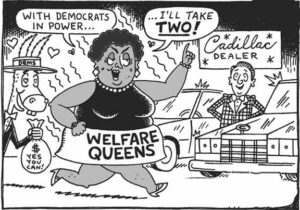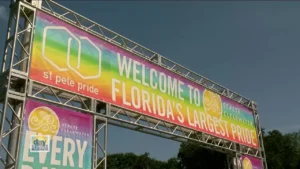- Feb 3, 2024
- LitBits
- 0
New blog post by Jason L. – discussions in this thread, please
---
This year, for the first, time, I noticed the absence of something in June: rainbows.
I’d never been particularly in love with them. The fact that Subaru will slap a rainbow on their ads, or that once a year a random company I never really patronize will reassure me how much they like the gays, has never moved the needle for me one way or the other. But this was the first year that I noticed how few of them there were to see, and for the first June in a long time, I felt worried.
It’s been building up: in the 2022 mid-term elections, I got this flyer in the mail in the state of Florida, and I want you to see it.

For those of you not clear what’s going on here, it’s of a person with a mustache and false eyelashes, and the caption reads “Thank you, Joe Biden and (Democratic Florida Senator) Charlie Cristie for making Floridians Pay off my student debt. Sent from the Republican Party of Florida. Don’t believe me? There’s a clearer link here.
We’ve seen it? Are we all appalled? Now let’s deconstruct it together. There’s a lot going on here. Let’s talk about what I see and what they’re tapping into.
This visual image is, obviously, of a college graduate whom we could say is non-gender-conforming. Both the frills and the use of makeup indicate that this student has a more provocative and non-traditional self-projection.
There are many economic arguments against student loan forgiveness, but this one taps into a cultural argument. By representing an outlier, the advertisement is communicating a false image of who, by and large, would be getting that forgiveness. Notice that there are no struggling single parents or people of color. No, this person seems to be male, white, and gleeful.
What it’s saying is that those people don’t deserve it.
Americans tend to be less uncomfortable when women experiment with gender norms than when men do. A “tomboy”, even as an adult, is far more unremarkable than a male who is experimenting with feminine fashion. Even as children, boys are discouraged from enjoying butterflies, flowers, and unicorns.
By choosing this image, the Republican Party wanted to alarm and shock. We assume that the student majored in something “useless”—often sneered at, dismissively, as gender studies by those who believe that college should be for manlier and less arcane subjects. Even given that, there’s no context. Is this student doing it for a fraternity prank? Is it a general experimentation with gender? Are we assuming that LGBTQ people cannot or naturally avoid STEM majors and focus on the frivolous and silly? More to the point, why is it our business to pass judgment upon someone who seems to be enjoying themselves?
The ambiguity of the model in the picture was picked to anger conservatives. At the end of the day, what the real message here is that since the government cannot discriminate between the worthy and unworthy legal behaviors, it is better that the benefit be cancelled altogether for everybody.
There are plenty of valid arguments in terms of economics, inflation, and precedent. But this is not one of them. But this argument itself has a disturbing history. Ultimately, this is a regressive image that gambles that the people receiving this message have an inner core of anti-gay prejudice that can be counted upon as a guide when it comes to the polls.
Think that this is an outlier? Let’s look at this image from the early 1980s:

Ronald Reagan, who wanted to end the Welfare system, created the myth of the “Welfare Queen” based on one, cherry-picked case of welfare fraud. By creating and spreading the notion that women of color, especially in the cities, were “gaming” the system, he successfully managed to convince rural white voters that they needed to take steps to end or limit welfare. Why is that significant? Because just like in the case of student debt coverage, rural white males, especially in the South, are the most frequent long-term users of welfare programs. (Urban women of color were among the least likely groups to be on welfare).
And it wasn’t the first time, either. When riots broke out at Berkeley in the 1960s and 1970s during student protests, conservatives used it as a reason to gut spending on higher education. At the time, Berkeley charged no or very limited tuition. “We’re financing radicals!” said Reagan and his cadre of small-government goons. “KILL IT WITH FIRE!” By doing that, they were able to convince nervous taxpayers to vote against something that enabled free and low-cost education to the poorest members of society. With the presence of more detailed analytical data about what people love and hate, both parties have enthusiastically tackled the bogeymen and demons hiding in the back of everyone’s mind and weaponized them to their own advantage.
In other words, just as in the case of the student-debt argument, this cartoon is trying to harness people’s prejudices convince them to vote against their own interests. I wanted to share this because a lot of people are appalled but they are not actually connecting the dots to the actual strategy being employed here, and why it’s dangerous for all LGBT people.
And that brings me back to the rainbow deficit this year. This weekend will be the Saint Petersburg Pride festival. It is the largest in the Southeast and will attract over 300,000 people to the Sunshine City. But it comes within an ominous moment. The 2020s have seen a reassertion of conservative voices throughout the country. Conservative pundits now openly discuss gay marriage as a marker of the decline of our civilization, while canny international politicians like Vladimir Putin have weaponized the issue to assert his vision of “manlier” Russia fit to take on the effeminate West. It is Edward Saïd’s Orientalism in reverse.
 In the face of that, the Pride celebration in St. Petersburg is an existential howl. It is a declaration of existence that should never have been needed to begin with but is starting to feel incredibly necessary. Over 25% of LGBT people go back into the closet after college, silencing themselves at the workplace with the implicit understanding that their private lives will impede their careers. Taken in the light of the increasingly dire Don’t-Say-Gay bills first introduced in Florida and exported throughout the country, the Pride celebrations have the feel of Weimar Berlin. It’s a colorful, flashy display of exuberance while predators circle around, waiting to pick off the weak and gloat at their downfall. It makes Pride events like these necessary on the macrolevel.
In the face of that, the Pride celebration in St. Petersburg is an existential howl. It is a declaration of existence that should never have been needed to begin with but is starting to feel incredibly necessary. Over 25% of LGBT people go back into the closet after college, silencing themselves at the workplace with the implicit understanding that their private lives will impede their careers. Taken in the light of the increasingly dire Don’t-Say-Gay bills first introduced in Florida and exported throughout the country, the Pride celebrations have the feel of Weimar Berlin. It’s a colorful, flashy display of exuberance while predators circle around, waiting to pick off the weak and gloat at their downfall. It makes Pride events like these necessary on the macrolevel.

And that is why those rainbows, that empty pursuit of my consumer loyalty, is so dearly missed this year. Target’s quiet walk-back of Pride decorations and the forced closure of DEI programs in universities around the country are a deeply concerning bellwether for the state of LGBT acceptance. For the first time in decades, American’s acceptance of gay marriage has plateaued and even seen some declines.
When the ink on your rights is still wet, it can be smudged quite a lot before the paper’s dry.
And it’s raining now.
---
By @Jason L.
Get the discussion going – post your thoughts & comments in the thread below…
---
This year, for the first, time, I noticed the absence of something in June: rainbows.
I’d never been particularly in love with them. The fact that Subaru will slap a rainbow on their ads, or that once a year a random company I never really patronize will reassure me how much they like the gays, has never moved the needle for me one way or the other. But this was the first year that I noticed how few of them there were to see, and for the first June in a long time, I felt worried.
It’s been building up: in the 2022 mid-term elections, I got this flyer in the mail in the state of Florida, and I want you to see it.

For those of you not clear what’s going on here, it’s of a person with a mustache and false eyelashes, and the caption reads “Thank you, Joe Biden and (Democratic Florida Senator) Charlie Cristie for making Floridians Pay off my student debt. Sent from the Republican Party of Florida. Don’t believe me? There’s a clearer link here.
We’ve seen it? Are we all appalled? Now let’s deconstruct it together. There’s a lot going on here. Let’s talk about what I see and what they’re tapping into.
This visual image is, obviously, of a college graduate whom we could say is non-gender-conforming. Both the frills and the use of makeup indicate that this student has a more provocative and non-traditional self-projection.
There are many economic arguments against student loan forgiveness, but this one taps into a cultural argument. By representing an outlier, the advertisement is communicating a false image of who, by and large, would be getting that forgiveness. Notice that there are no struggling single parents or people of color. No, this person seems to be male, white, and gleeful.
What it’s saying is that those people don’t deserve it.
Americans tend to be less uncomfortable when women experiment with gender norms than when men do. A “tomboy”, even as an adult, is far more unremarkable than a male who is experimenting with feminine fashion. Even as children, boys are discouraged from enjoying butterflies, flowers, and unicorns.
By choosing this image, the Republican Party wanted to alarm and shock. We assume that the student majored in something “useless”—often sneered at, dismissively, as gender studies by those who believe that college should be for manlier and less arcane subjects. Even given that, there’s no context. Is this student doing it for a fraternity prank? Is it a general experimentation with gender? Are we assuming that LGBTQ people cannot or naturally avoid STEM majors and focus on the frivolous and silly? More to the point, why is it our business to pass judgment upon someone who seems to be enjoying themselves?
The ambiguity of the model in the picture was picked to anger conservatives. At the end of the day, what the real message here is that since the government cannot discriminate between the worthy and unworthy legal behaviors, it is better that the benefit be cancelled altogether for everybody.
There are plenty of valid arguments in terms of economics, inflation, and precedent. But this is not one of them. But this argument itself has a disturbing history. Ultimately, this is a regressive image that gambles that the people receiving this message have an inner core of anti-gay prejudice that can be counted upon as a guide when it comes to the polls.
Think that this is an outlier? Let’s look at this image from the early 1980s:

Ronald Reagan, who wanted to end the Welfare system, created the myth of the “Welfare Queen” based on one, cherry-picked case of welfare fraud. By creating and spreading the notion that women of color, especially in the cities, were “gaming” the system, he successfully managed to convince rural white voters that they needed to take steps to end or limit welfare. Why is that significant? Because just like in the case of student debt coverage, rural white males, especially in the South, are the most frequent long-term users of welfare programs. (Urban women of color were among the least likely groups to be on welfare).
And it wasn’t the first time, either. When riots broke out at Berkeley in the 1960s and 1970s during student protests, conservatives used it as a reason to gut spending on higher education. At the time, Berkeley charged no or very limited tuition. “We’re financing radicals!” said Reagan and his cadre of small-government goons. “KILL IT WITH FIRE!” By doing that, they were able to convince nervous taxpayers to vote against something that enabled free and low-cost education to the poorest members of society. With the presence of more detailed analytical data about what people love and hate, both parties have enthusiastically tackled the bogeymen and demons hiding in the back of everyone’s mind and weaponized them to their own advantage.
In other words, just as in the case of the student-debt argument, this cartoon is trying to harness people’s prejudices convince them to vote against their own interests. I wanted to share this because a lot of people are appalled but they are not actually connecting the dots to the actual strategy being employed here, and why it’s dangerous for all LGBT people.
And that brings me back to the rainbow deficit this year. This weekend will be the Saint Petersburg Pride festival. It is the largest in the Southeast and will attract over 300,000 people to the Sunshine City. But it comes within an ominous moment. The 2020s have seen a reassertion of conservative voices throughout the country. Conservative pundits now openly discuss gay marriage as a marker of the decline of our civilization, while canny international politicians like Vladimir Putin have weaponized the issue to assert his vision of “manlier” Russia fit to take on the effeminate West. It is Edward Saïd’s Orientalism in reverse.


And that is why those rainbows, that empty pursuit of my consumer loyalty, is so dearly missed this year. Target’s quiet walk-back of Pride decorations and the forced closure of DEI programs in universities around the country are a deeply concerning bellwether for the state of LGBT acceptance. For the first time in decades, American’s acceptance of gay marriage has plateaued and even seen some declines.
When the ink on your rights is still wet, it can be smudged quite a lot before the paper’s dry.
And it’s raining now.
---
By @Jason L.
Get the discussion going – post your thoughts & comments in the thread below…
